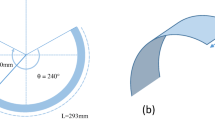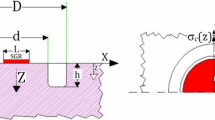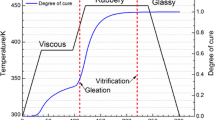Abstract
Controlling the fabrication process induced shape distortion in composite parts is a concern of composite industry and relevant researchers in the recent year. This study focused on the numerical as well as experimental investigation of the effect of addition of silica microparticles on the mechanical properties and the cured shape of glass/vinyl ester angled composite parts. UD glass fabric/ vinyl ester laminated composite parts were fabricated without and with the addition of silica microparticles. The thermal and mechanical properties of resin samples containing silica particles were characterised using Dilatometer and Universal Testing Machine. It was found that the addition of silica microparticles has reduced the thermal expansion coefficients (CTE) and increased the modulus of resin. These thermal and mechanical properties were then used as matrix properties for three-phase composite laminated parts. The analytical micromechanical model was used to determine the thermomechanical properties of composite lamina. The numerical investigations of spring-in in angled composite parts were performed on commercial FEA software, COMSOL Multiphysics® (v5.4). The experimental results showed that the angled part without any fillers had a higher spring-in value of 1.807°, while the other part having 5% fillers exhibited a lower spring-in value of 0.632° only. The numerical results were found to be in close agreement with the experimental results.









Similar content being viewed by others
References
Wenani M, Andersen L, Horlyk P, Nielsen MW (2012) Prediction of process induced shape distortions and residual stresses in large - with application to wind turbine blades. Technical University of Denmark
Haghshenas SM, Vaziri R, Poursartip A (2018) Integration of resin flow and stress development in process modelling of composites: part I – isotropic formulation. J Compos Mater 52(23):002199831876229. https://doi.org/10.1177/0021998318762295
Nawab Y, Tardif X, Boyard N, Sobotka V, Casari P, Jacquemin F (2012) Determination and modelling of the cure shrinkage of epoxy vinylester resin and associated composites by considering thermal gradients. Compos Sci Technol 73:81–87
Wijskamp S (2005) Shape distortions in composites forming. University of Twente
Wisnom MR, Gigliotti M, Ersoy N, Campbell M, Potter KD (2006) Mechanisms generating residual stresses and distortion during manufacture of polymer–matrix composite structures. Compos Part A Appl Sci Manuf 37(4):522–529. https://doi.org/10.1016/j.compositesa.2005.05.019
Kim H-S, Yoo S-H, Chang S-H (2013) In situ monitoring of the strain evolution and curing reaction of composite laminates to reduce the thermal residual stress using FBG sensor and dielectrometry. Compos Part B Eng 44(1):446–452
Albert C, Fernlund G (2002) Spring-in and warpage of angled composite laminates. Compos Sci Technol 62(14):1895–1912
Ali M, Nawab Y, Saouab A, Anjum AS, Zeeshan M (2017) Fabrication induced spring-back in thermosetting woven composite parts with variable thickness. J Ind Text 152808371668693(6). https://doi.org/10.1177/1528083716686939
Potter KD, Campbell M, Langer C, Wisnom MR (2005) The generation of geometrical deformations due to tool/part interaction in the manufacture of composite components. Compos Part A Appl Sci Manuf 36(2):301–308. https://doi.org/10.1016/j.compositesa.2004.06.002
Parlevliet PP, Bersee HEN, Beukers A (2006) Residual stresses in thermoplastic composites—a study of the literature—part I: formation of residual stresses. Compos Part A Appl Sci Manuf 37(11):1847–1857. https://doi.org/10.1016/j.compositesa.2005.12.025
Nawab Y, Park CH, Saouab A, Agogué R, Beauchêne P, Desjoyaux B (2014) Shape distortion of carbon/epoxy composite parts during fabrication. Macromol Symp 340(1):59–64. https://doi.org/10.1002/masy.201300124
Stavrovsky V, Ruzicka M, Padovec Z, Chlup H (2011) Thermal and mechanical behaviour of the angle section of the composite with a single and double curvature. In: 18th international conference on composite materials, Jeju Island, Korea, pp 1–6
Jain LK, Lutton BG, Mai Y, Paton R (1997) Stresses and deformations induced during manufacturing. Part II: a study of the spring in phenamenon. J Compos Mater 31(7):696–719. https://doi.org/10.1177/002199839703100704
Kappel E, Stefaniak D, Hühne C (2013) Process distortions in prepreg manufacturing – an experimental study on CFRP L-profiles. Compos Struct 106:615–625. https://doi.org/10.1016/J.COMPSTRUCT.2013.07.020
Hubert P, Poursartip A (2001) Aspects of the Compaction of Composite Angle Laminates: An Experimental Investigation. J Compos Mater 35:2–26. https://doi.org/10.1177/002199801772661849
Composites TP (1999) An investigation of cure induced stresses in low cure temprature thermoset polymer composites. J Reinf Plast Compos 18(14):1304–1321. https://doi.org/10.1177/073168449901801403
Kappel E (2015) Spring-in of curved CFRP/foam-core sandwich structures. Compos Struct 128:155–164. https://doi.org/10.1016/j.compstruct.2015.03.058
Ding A, Li S, Sun J, Wang J, Zu L (2016) A comparison of process-induced residual stresses and distortions in composite structures with different constitutive laws. J Reinf Plast Compos 35(10):807–823. https://doi.org/10.1177/0731684416629764
Fiorina M, Seman A, Castanie B, Ali KM, Schwob C, Mezeix L (2017) Spring-in prediction for carbon/epoxy aerospace composite structure. Compos Struct 168:739–745. https://doi.org/10.1016/j.compstruct.2017.02.074
Hajbarati H, Zajkani A (2019) A novel analytical model to predict springback of DP780 steel based on modified Yoshida-Uemori two-surface hardening model. Int J Mater Form 12(3):441–455. https://doi.org/10.1007/s12289-018-1427-2
Raza M, Shaker K, Nawab Y, Saouab A (2019) Reduction in process-induced shape distortion of C-shaped composite parts using micro silica particles. Int J Adv Manuf Technol 103(9-12). https://doi.org/10.1007/s00170-019-03981-y
Suresha B, Chandramohan G (2008) Three-body abrasive wear behaviour of particulate-filled glass-vinyl ester composites. J Mater Process Technol 200(1-3):306–311. https://doi.org/10.1016/j.jmatprotec.2007.09.035
Zhu J, Imam A, Crane R et al (2007) Processing a glass fiber reinforced vinyl ester composite with nanotube enhancement of interlaminar shear strength. Compos Sci Technol 67(7-8):1509–1517. https://doi.org/10.1016/j.compscitech.2006.07.018
Chandradass J, Kumar MR, Velmurugan R (2007) Effect of nanoclay addition on vibration properties of glass fibre reinforced vinyl ester composites. Mater Lett 61(22):4385–4388. https://doi.org/10.1016/j.matlet.2007.02.009
Dittanet P, Pearson RA (2012) Effect of silica nanoparticle size on toughening mechanisms of filled epoxy. Polymer (Guildf) 53(9):1890–1905. https://doi.org/10.1016/j.polymer.2012.02.052
Nawab Y, Jaquemin F, Casari P, Boyard N, Sobotka V (2012) Evolution of chemical and thermal curvatures in thermoset-laminated composite plates during the fabrication process. J Compos Mater 47(3):327–339. https://doi.org/10.1177/0021998312440130
Lee E, Lee S, Shanefieldz DJ, Cannonw WR (2008) Enhanced thermal conductivity of polymer matrix composite via high solids loading of aluminum nitride in epoxy resin. J Am Ceram Soc 91(4):1169–1174. https://doi.org/10.1111/j.1551-2916.2008.02247.x
Kroner E (1958) Calculation of the elastic constants of the multicrystal from the constants of the single crystal. J Phys A Hadron Nucl 151(4):504–518. https://doi.org/10.1007/BF01337948
Eshelby JD (1957) The determination of the elastic field of an ellipsoidal inclusion, and related problems. Proc R Soc A Math Phys Eng Sci 241(1226):376–396. https://doi.org/10.1098/rspa.1957.0133
Jacquemin F, Freour S, Guillen R (2005) A Hygroelastic self-consistent model for Fiber-reinforced Composites. J Reinf Plast Compos 24(5):485–502. https://doi.org/10.1177/0731684405045014
Msallem YA, Jacquemin F, Poitou A (2010) Residual stresses formation during the manufacturing process of epoxy matrix composites: resin yield stress and anisotropic chemical shrinkage. Int J Mater Form 3(S2):1363–1372. https://doi.org/10.1007/s12289-010-0688-1
Fu SY, Feng XQ, Lauke B, Mai YW (2008) Effects of particle size, particle/matrix interface adhesion and particle loading on mechanical properties of particulate-polymer composites. Compos Part B Eng 39(6):933–961. https://doi.org/10.1016/j.compositesb.2008.01.002
Shaker K, Nawab Y, Saouab A, Ashraf M (2018) Effect of silica particle loading on shape distortion in glass / vinyl ester-laminated composite plates. J Text Inst 109(5):656–664. https://doi.org/10.1080/00405000.2017.1363932
Shunmugasamy VC, Pinisetty D, Gupta N (2012) Thermal expansion behavior of hollow glass particle/vinyl ester composites. J Mater Sci 47(14):5596–5604. https://doi.org/10.1007/s10853-012-6452-9
Author information
Authors and Affiliations
Corresponding author
Ethics declarations
Conflict of interest
The authors declare that they have no conflict of interest.
Additional information
Publisher’s note
Springer Nature remains neutral with regard to jurisdictional claims in published maps and institutional affiliations.
Rights and permissions
About this article
Cite this article
Shaker, K., Nawab, Y. & Saouab, A. Experimental and numerical investigation of reduction in shape distortion for angled composite parts. Int J Mater Form 13, 897–906 (2020). https://doi.org/10.1007/s12289-019-01510-6
Received:
Accepted:
Published:
Issue Date:
DOI: https://doi.org/10.1007/s12289-019-01510-6




